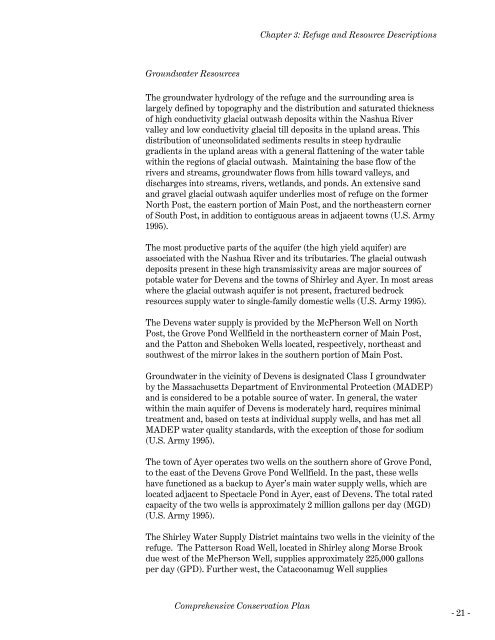Oxbow NWR Final CCP - U.S. Fish and Wildlife Service
Oxbow NWR Final CCP - U.S. Fish and Wildlife Service
Oxbow NWR Final CCP - U.S. Fish and Wildlife Service
You also want an ePaper? Increase the reach of your titles
YUMPU automatically turns print PDFs into web optimized ePapers that Google loves.
Groundwater Resources<br />
Chapter 3: Refuge <strong>and</strong> Resource Descriptions<br />
The groundwater hydrology of the refuge <strong>and</strong> the surrounding area is<br />
largely defined by topography <strong>and</strong> the distribution <strong>and</strong> saturated thickness<br />
of high conductivity glacial outwash deposits within the Nashua River<br />
valley <strong>and</strong> low conductivity glacial till deposits in the upl<strong>and</strong> areas. This<br />
distribution of unconsolidated sediments results in steep hydraulic<br />
gradients in the upl<strong>and</strong> areas with a general flattening of the water table<br />
within the regions of glacial outwash. Maintaining the base flow of the<br />
rivers <strong>and</strong> streams, groundwater flows from hills toward valleys, <strong>and</strong><br />
discharges into streams, rivers, wetl<strong>and</strong>s, <strong>and</strong> ponds. An extensive s<strong>and</strong><br />
<strong>and</strong> gravel glacial outwash aquifer underlies most of refuge on the former<br />
North Post, the eastern portion of Main Post, <strong>and</strong> the northeastern corner<br />
of South Post, in addition to contiguous areas in adjacent towns (U.S. Army<br />
1995).<br />
The most productive parts of the aquifer (the high yield aquifer) are<br />
associated with the Nashua River <strong>and</strong> its tributaries. The glacial outwash<br />
deposits present in these high transmissivity areas are major sources of<br />
potable water for Devens <strong>and</strong> the towns of Shirley <strong>and</strong> Ayer. In most areas<br />
where the glacial outwash aquifer is not present, fractured bedrock<br />
resources supply water to single-family domestic wells (U.S. Army 1995).<br />
The Devens water supply is provided by the McPherson Well on North<br />
Post, the Grove Pond Wellfield in the northeastern corner of Main Post,<br />
<strong>and</strong> the Patton <strong>and</strong> Sheboken Wells located, respectively, northeast <strong>and</strong><br />
southwest of the mirror lakes in the southern portion of Main Post.<br />
Groundwater in the vicinity of Devens is designated Class I groundwater<br />
by the Massachusetts Department of Environmental Protection (MADEP)<br />
<strong>and</strong> is considered to be a potable source of water. In general, the water<br />
within the main aquifer of Devens is moderately hard, requires minimal<br />
treatment <strong>and</strong>, based on tests at individual supply wells, <strong>and</strong> has met all<br />
MADEP water quality st<strong>and</strong>ards, with the exception of those for sodium<br />
(U.S. Army 1995).<br />
The town of Ayer operates two wells on the southern shore of Grove Pond,<br />
to the east of the Devens Grove Pond Wellfield. In the past, these wells<br />
have functioned as a backup to Ayer’s main water supply wells, which are<br />
located adjacent to Spectacle Pond in Ayer, east of Devens. The total rated<br />
capacity of the two wells is approximately 2 million gallons per day (MGD)<br />
(U.S. Army 1995).<br />
The Shirley Water Supply District maintains two wells in the vicinity of the<br />
refuge. The Patterson Road Well, located in Shirley along Morse Brook<br />
due west of the McPherson Well, supplies approximately 225,000 gallons<br />
per day (GPD). Further west, the Catacoonamug Well supplies<br />
Comprehensive Conservation Plan<br />
- 21 -

















